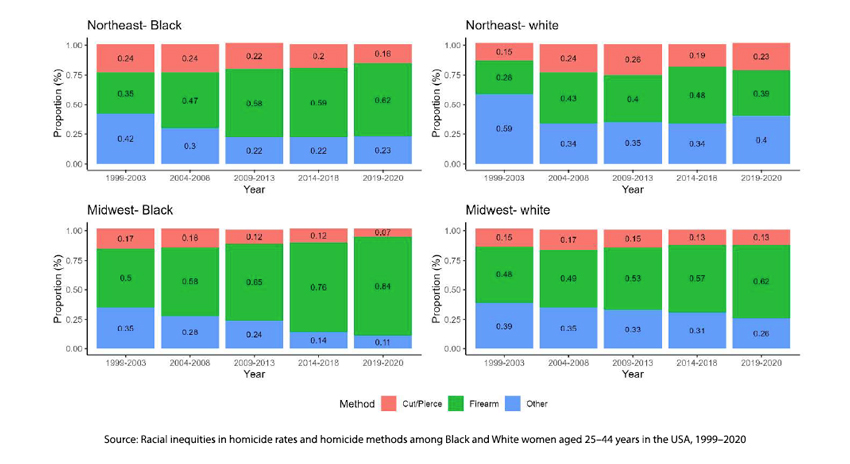“In 2020, the homicide rate among Black women was 11.6 per 100,000, compared with 3.0 per 100,000 among White women. This inequity has persisted over time and is virtually unchanged since 1999.”
That is both the opening line and bottom line of a study just reported in Lancet. Before jumping in, let’s put the dataset in context. It comes from the CDC and the National Vital Statistics System, the most complete record of deaths in the US. It looked at women aged 25-44, dying between 1999 and 2020. Race was self-reported and restricted to White and Black, which may have included some better characterized as Hispanic. It considered data from 30 states with sufficient data to be included in the NVSS (>9 homicides annually).
Note: the study frequently uses the term inequities, presumably speaking to the numeric difference; any reasonable person will conclude that any murder, irrespective of gender or race, is an inequity.
Here are some of the findings from the study.
- State-level homicide rates for women varied from 6.6 per 100,000 in Alabama to 1·6 per 100,000 in Massachusetts. But across the entire period, Black women were killed disproportionately compared to White women.
- Homicide rate inequities categorized by race were greatest in the Midwest states.
- Irrespective of race, guns were the most common weapon, with physical brutality or knives trailing behind.

The researchers point out that more Black women were killed with guns than White women, another “inequity.” That is merely the preamble to their “more nuanced understanding” that
“US states with the greatest racial inequities in homicide rates correlate with areas of the country where there are substantial structural inequities delineated along wealth markers, namely educational attainment, employment type and status, and extreme poverty.”
While pointing out that “a structural analysis was outside of the scope of this inquiry,” it is that lens that was used to discuss these inequalities. But can we not agree that murdering anyone, male or female, is at the least an inequity. We should not let our analysis lead to paralysis.
When Men Murder Women
That is the provocative title of an article on the website for the Violence Policy Center, admittedly a non-profit dedicated to gun control. But the following data comes from the FBI’s state-by-state 2020 Supplementary Homicide Report
- Homicides in which race was identified (2,004 victims) included 44 American Indian or Alaskan Native females, 60 Asian or Pacific Islander females, 641 Black females, and 1,259 white females. Eighty-three percent of the homicides where the race of the female victim and male offender were known were intra-racial.
- In 2020, 89% of female victims (1,604 out of 1,801) were killed by someone familiar. Of those acquainted with their offenders, 60% (967 out of 1,604) were wives, common-law wives, ex-wives, or girlfriends. (Ex-boy or girlfriends were not counted as they are not designated in FBI reports.)
- Firearms were the weapon most used by males to murder females in 2020; 61 % of female victims (1,057 out of 1,735) were killed with a gun. 53 % were murdered by male intimates, nearly three times higher than the total number murdered by male strangers using all weapons combined.
- 88% of female homicides by male offenders were not associated with any other felony crime.
- Within this category, 58% of the homicides were a result of arguments between the female victim and male offender. Among the homicides stemming from arguments, 56% involved the use of firearms.
“The racial/ ethnic differences in female homicide underscore the importance of targeting prevention and intervention efforts to populations at disproportionately high risk. Addressing violence will require an integrated response that considers the influence of larger community and societal factors that make violence more likely to occur.”
- Emiko Petrosky, Medical Epidemiologist CDC
Might we agree that the availability of guns, which are very efficient means of ending a life, as demonstrated by statistics on suicide as well as murder, might be a targeted prevention and intervention? That question lies with the Supreme Court in a case entitled United States v. Rahimi [1]
The Case and Question
“Between December 2020 and January 2021, Zackey Rahimi was involved in a series of violent incidents in Arlington, Texas, including multiple shootings and a hit-and-run. Rahimi was under a civil protective order for alleged assault against his ex-girlfriend, which explicitly prohibited him from possessing firearms. Police searched his home and found a rifle and a pistol, leading to Rahimi’s indictment for violating federal law 18 USC § 922(g)(8), which makes it unlawful for someone under a domestic violence restraining order to possess firearms. Rahimi moved to dismiss the indictment on constitutional grounds but was denied, as his argument was foreclosed by United States v. McGinnis, 956 F.3d 747 (5th Cir. 2020).
Rahimi pleaded guilty but continued his constitutional challenge on appeal. As the appeal was pending, the US Supreme Court decided New York State Rifle & Pistol Association, Inc. v. Bruen, 579 US __ (2022). Rahimi argued that Bruen overruled McGinnis and thus that § 922(g)(8) was unconstitutional, and the US Court of Appeals for the Fifth Circuit agreed.
Does 18 USC § 922(g)(8), which prohibits the possession of firearms by persons subject to domestic-violence restraining orders, violate the Second Amendment?”
I am not an attorney and certainly not a legal scholar. My colleague, Dr. Billauer, helps me in this regard. But I did listen to the arguments made before the Supremes. The counsel representing the Federal Government made two arguments.
The first speaks to the issue of originalism. There are acknowledged limits to the Second Amendment, but in the Bruen decision, a change was made in testing for those limitations. In essence, the test leans more heavily on historical traditions of firearms regulation rather than contemporary public safety issues.
“Legislatures have made a judgment that it is dangerous to have people carrying weapons about. Legislatures made a judgment it's dangerous for handguns specifically to be possessed. And the Court didn't defer to those late or mid-20th Century judgments or even early 20th Century judgments about dangerousness in that scenario. Instead, the Court said we are going to follow our understanding of the original public meaning of the text and -- as illuminated by the historical tradition of firearms regulation at the margins.”
- J. Matthew Wright, representing the petitioner, Mr. Rahimi
“I think that in many instances, courts are placing dispositive weight on the absence of regulation in a circumstance where there's no reason to think that was due to constitutional concerns. So, for, example here, we don't have a regulation disarming domestic abusers.
But there is nothing on the other side of the interpretive question in this case to suggest that anyone thought you couldn't disarm domestic abusers or couldn't disarm dangerous people.”
- Solicitor General, Elizabeth Prelogar
The second argument is around several legal terms.
“Dangerous”
The government argues that “dangerous” means someone likely to pose a risk of harm to themselves or others and that the historical record supports this definition. The government points to laws that have been enacted to disarm people who are considered dangerous, such as felons and people with mental illness. Criminal proceedings are designed to punish people for crimes they have already committed; dangerousness is determined after a conviction because they have already committed an act that society deems harmful.
Mr. Rahimi’s prohibition began with a civil protective order. In civil proceedings, the person has not necessarily committed a crime. Still, a court has found that they are likely to do so in the future – dangerousness is based on a prediction of future behavior. Critics of the government’s argument argue that the definition of “dangerous” is too broad and that it could be used to disarm people who are not actually a threat to public safety. They argue that the government should focus on disarming people who have been convicted of violent crimes or who have a history of violence.
The Supreme Court has not yet ruled on the meaning of “dangerous” in the context of the Second Amendment.
“Law-abiding” and “Responsible.”
The government argues that the terms “law-abiding” and “responsible” are synonymous and refer to people who are not a danger to themselves or others. The government further argues that it has a legitimate interest in disarming people who are not law-abiding or responsible in order to protect public safety.
“This case focuses on the "not responsible citizens" principle, and in this context, we think that history and tradition show that it applies to those whose possession of rearms would pose an unusual danger, beyond the ordinary citizen, with respect to harm to themselves or harm to others.”
Mr. Rahimi’s counsel argues that the terms are not synonymous and should be interpreted more narrowly. The term “law-abiding” refers to people who have not been convicted of a crime, while “responsible” refers to people who are not a danger to themselves or others. The petitioner further argues that the government’s interest in disarming people who are not law-abiding or responsible is outweighed by the Second Amendment right to keep and bear arms.
The Lancet study sheds light on the disturbing reality of homicide rates among American women. The prevalence of guns as the weapon of choice, especially in cases of domestic violence, underscores the need for a nuanced understanding of the legal debate regarding the balance between individual rights and the government's interest in public safety. The outcomes of such legal deliberations have far-reaching implications for the safety and well-being of individuals, particularly women, who are disproportionately affected by these issues.
[1] The case description and transcript of the oral arguments before the US Supreme Court comes from the website Oyez. This is a wonderful source if you are interested in an unfiltered view of their proceedings.
Source: Racial inequities in homicide rates and homicide methods among Black and White women aged 25–44 years in the USA, 1999–2020: a cross-sectional time series study The Lancet DOI: 10.1016/S0140-6736(23)02279-




